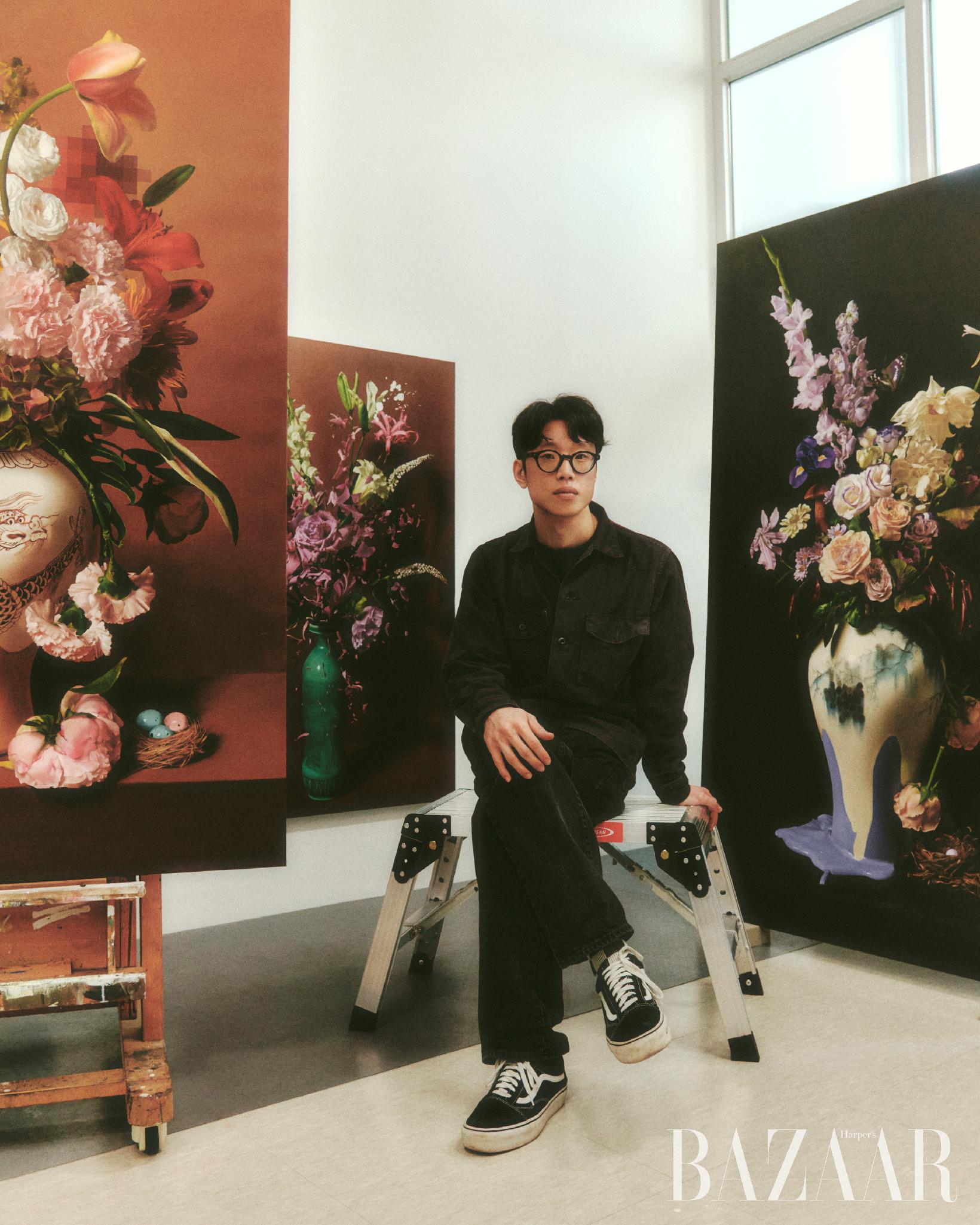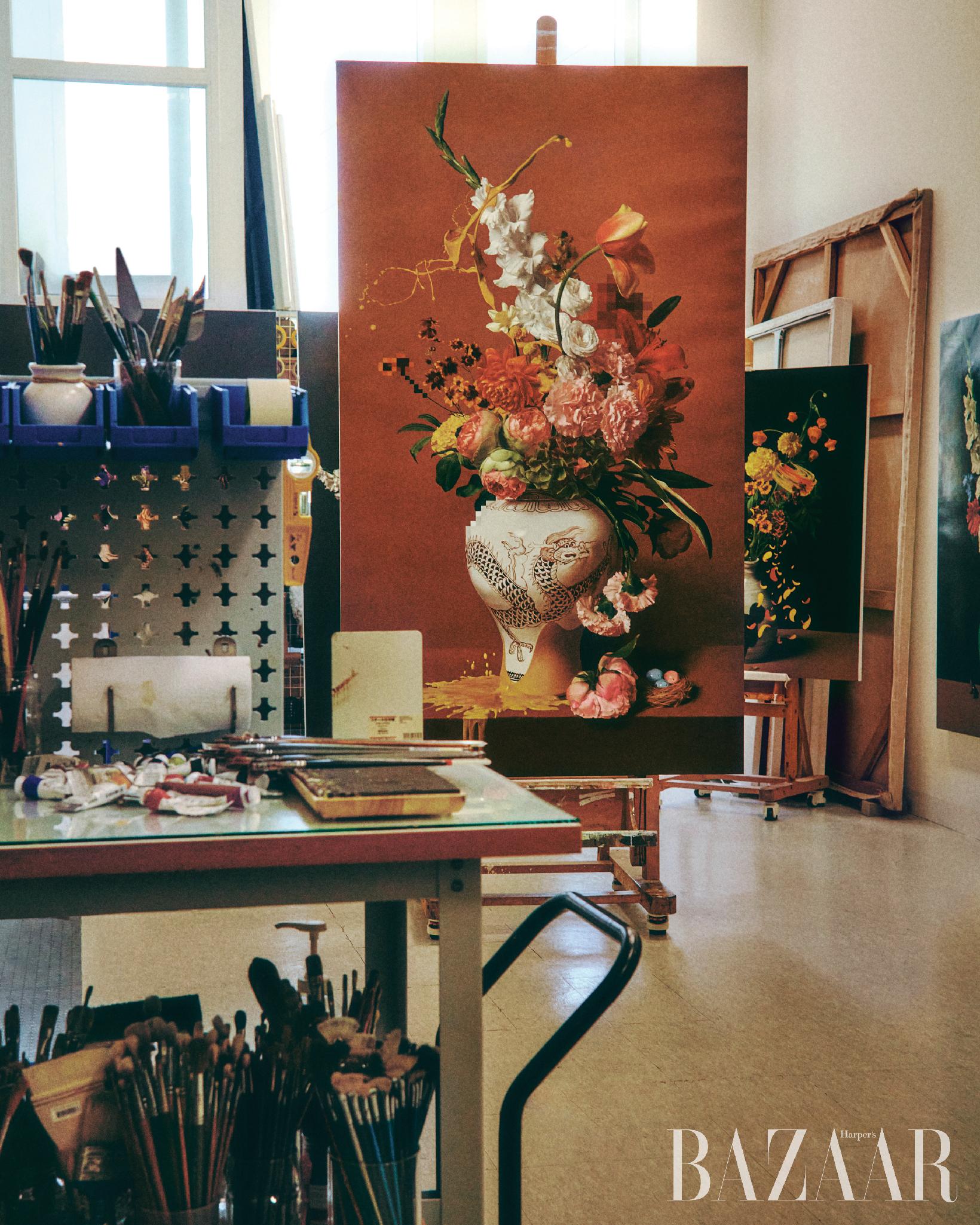
Kim Sung Yoon’s solo presentation at Frieze Los Angeles 2024 departs from the artist’s floral arrangements from the 2019 solo exhibition Arrangement. Within a space that condenses the past, present, and future, flower petals shed and dissolve into smoke or burst into clouds of pigment. Possibilities permeate where fissures form. As with Cézanne's apples, flowers can be employed as a medium that divides our reality into multiple layers. I was most curious to witness the level of determination or steadfastness it would entail for a figurative painter to sustain his practice of drawing still lifes today, amidst the innovation and novelty that typically becomes associated with contemporary art. According to Kim, "Contemporary art is an institutionalized transgression. A sculpture of Jesus must be placed in a urinal and a Madonna should be smeared with an elephant’s excrement. To be completely frank, I don’t see the fun of it." To roughly sum up our conversation that day, we agreed that transgression for the sake of transgression is rather banal.

Harper's Bazaar: In your 2019 solo exhibition Arrangement, you adopted the canons of 17th-century still lifes, placing flowers that could never bloom together within a linear dimension of space and time. This year's solo presentation at Frieze LA is an extended study, with compounded by imagery of bursting flower petals and melting vases. What changed over these past four years?
Kim Sung Yoon: I've memorized the names of the flowers I paint. It's found that a culture without a word for “red” cannot recognize the color even when they see it. Language affects vision. I now have a better understanding of flowers after memorizing their names. My paintings present a totality of layers and my goal is to coherently coat each layer in order to create an passable painting. Akin to how the lisianthus and dahlia seem to consist a single layer of the pictorial plane, so do the splatters of paint or shedding flower petals. One imagery becomes superimposed onto another, and with a better understanding of flowers, I have more freedom in constructing the layers. I'm glad that my painting skills are improving. The fact that I'm still improving at the age of forty gives me some kind of hope. (Laughter)
Harper's Bazaar: You've named your method of collecting flower images through Google as "Google flower arrangement." What is your process of collecting these images?
Kim Sung Yoon: I sometimes joke that I'm an artist striving to merge the online and offline. I find images on Google and Shutterstock, but I also visit the flower market every Tuesday night and Wednesday early morning. I arrange the flowers I bought from the market in a vase, take pictures, edit the images on Photoshop and add images collected online. Gathering images online is surprisingly very labor-intensive. I come across a single photograph that catches my eye only after making tens and thousands of searches. Just like you stumble upon a flower while taking a stroll, it takes a lot of time and effort to find the right image. What is important is that a routine structure of layers is most natural.
Harper's Bazaar: What’s a florist’s opinion on your flower arrangement?
Kim Sung Yoon: I took a flower arrangement class once before, but it was starkly different from my work. I only paint a frontal view of the arrangement, but florists have to keep either sides and the back in mind as well. It's more like a sculpture than a painting. Painters must fill the void with brushstrokes instead of flowers, which means that a wholesome flower arrangement isn’t necessarily the way to go.
Harper's Bazaar: What is the greatest joy in your practice?
Kim Sung Yoon: I feel a certain kind of rush when there’s a good day with the brushstrokes I apply—it doesn’t happen every day. There’s a palpable difference between when drawing male versus female figures, owing to their physical discrepancies. As such, each species of flora is different. For example, the Icelandic poppy petals are thin and creased like tissue paper, which makes it difficult for them to complement the other flowers. Some flowers are plain impossible to paint, and vice versa. I feel like I have picked up something special on days when I can successfully paint a flower about which I had so much doubt.
Harper's Bazaar: I was always curious to learn more about how contemporary figurative artists approach their practice today, and your comparison between the potential of still life in present day to the Western (as in the film genre) served as a clue: “Just like how the Western continues to be reintroduced and its directors employ this age-old setting in search of plots that are still relatable today, I hope that the same could happen with religious, historical, and still life paintings.”
Kim Sung Yoon: Gilles Deleuze once mentioned that the astonishing thing about genre isthat, a genre in and of itself provides solid ground for truth as it stands as accustomed truth for the public. Personally, I don’t understand why the characters in the cinematic setting of an auteur, like Kim Ki-duk, behave the way they do. On the other hand, Bong Joon-ho’s films function strictly within the framework of his signature genre. If you enjoy caper films, you can’t help but find Parasite entertaining because they share characteristics in common. The unexpectedness creates a twist. If the twist is outlandish or off the charts, the audience cannot relate. However, a subtle twist gives ample space for the characters in the film to share something in common with the viewers. My work is pretty much the same. The still life genre has evolved from the historical foundation from hundreds and thousands of years ago. I have no intention of making a drastic departure from still life as we know it. Contemporary art often portrays flowers in bizarre ways. However, I think flowers should be painted beautifully, in just the way they are.
Harper's Bazaar: What if you choose to depict something that’s not considered “beautiful”? Should it be depicted “beautifully,” still?
Kim Sung Yoon: I'm not an aestheticist. The essence of the subject should be effectively portrayed. What is beautiful should stay beautiful and what is grotesque should stay grotesque.
Harper's Bazaar: Yet, the world remembers its innovators.
Kim Sung Yoon: Indeed, like Picasso. People who focus on making big changes seem to have bigger egos. The act of filtering a subject from one’s point of view and projecting it onto the canvas evinces the will to change the world. Picasso’s depictions of Africa implies his infamous colonial superiority complex. In Matisse’s paintings of flowers, for example, it is impossible to deduce the kinds of flowers he is portraying. I think this is indicative of the artist’s somewhat violent perspective, where his brushstrokes and use of color removed the innate features of the subject. I’m intrinsically distant from such an approach. I am not interested in making a big change but rather in making a visible difference.
Harper's Bazaar: What does tradition or the past mean to you? You once said, "For modernists, the past is undertaken as an antithesis that must be denied but in my case, the past is like a living, breathing creature."
Kim Sung Yoon: Jeff Wall, who captures art historical compositions through photography, once said, “Contemporary art is a system where transgression is institutionalized.” In contemporary art, transgression is habitual, and the institution imposes transgression. His words continue to resonate with me. All artists before the 1990s paid homage to what humanity had done for thousands of years. Rubens, and even Manet, followed suit. People think of Manet as an artist who desired to break away from tradition and create something original but such was not the case. Instead of participating in the Salon des Refusés led by Renoir, he continuously wanted to enter the Salon. He also painted traditional iconography in his Parisian genre painting. In this respect, Manet respected tradition and the past. Like Manet, it’s important to acknowledge and utilize heritage, to open up new possibilities. I don’t think you need to be obsessed with originality. Nowadays, people even make remixes of music from the 90s. There are infinite possibilities with the past.
Harper's Bazaar: John Singer Sargent's portraits and Édouard Manet’s still lifes have been a great inspiration for your body of work. What heritage interests you these days?
Kim Sung Yoon: I might try religious paintings in the near future. In contemporary art, religion is something that must be deconstructed and rejected. In other words, everyone has to become Richard Dawkins. (Laughter) Since contemporary art is an institutionalized transgression. A sculpture of Jesus must be placed in a urinal and a Madonna should be smeared with an elephant’s excrement. To be completely frank, I don’t see the fun of it. Whether God exists or not is not something an individual can simply decide. All I can do is modernize the genre so that it can become relatable today. I truly aspire to explore god and religion all I can, through art.
Harper's Bazaar: Perhaps you are a reactionary figure in today's ultra-futuristic society.
Kim Sung Yoon: Just because technology advances and apps like ChatGPT emerge, it doesn't mean that the world is progressing. Darwin mentioned that evolution is not necessarily progressive. Nevertheless, diversity is of most important value to me. I hate it when two people get into an argument. An ideal and hopeful society is where everyone can express their desires. The reason I admire contemporary art is because, unlike other fields, it acknowledges diversity and remains open to the idea. It is completely alright if an individual, like myself, does not seek for innovation. That is not what I am here for.
– Editor: Anna Son, Photographer: Kim Hyeong Sang